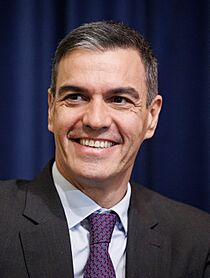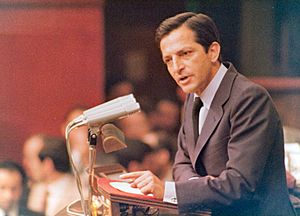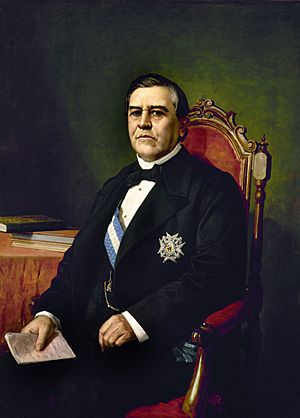Prime Minister of Spain facts for kids
Quick facts for kids Prime Minister of Spain |
|
|---|---|

|
|
| Government of Spain Office of the Prime Minister |
|
| Style | The Most Excellent |
| Member of |
|
| Reports to | Monarch Cortes Generales |
| Residence | Palace of Moncloa |
| Seat | Madrid, Spain |
| Nominator | The Congress of Deputies |
| Appointer | The Monarch |
| Term length | No fixed term |
| Deputy | Deputy Prime Minister |
| Salary | €90,000 per annum |
The prime minister of Spain, officially called the President of the Government (Spanish: Presidente del Gobierno), is the main leader of the Spanish government. The prime minister chooses the ministers and leads the Council of Ministers. This means the prime minister sets the government's plans and makes sure all Cabinet members work together. As the chief executive, the prime minister also advises the King or Queen on their special powers.
It's hard to say exactly when the role of prime minister began. But it has changed a lot over time to become what it is today. The idea of a prime minister leading the Council of Ministers first appeared in 1824. This was in a royal order from King Ferdinand VII. The current role was set up during the time of King Juan Carlos I. This happened with the 1978 Constitution. This important document explains what the prime minister does, how they get the job, how they can be removed, and how they work with the Parliament.
When the position is empty, the King or Queen suggests a person. This person then needs to be approved by the Congress of Deputies. This is the lower house of the Spanish Parliament. This process is how the head of government is chosen by the Congress. Usually, the prime minister is the leader of the party with the most seats in the Congress. However, this is not always the case. The prime minister's official home and office is the Moncloa Palace in Madrid.
Pedro Sánchez, from the Spanish Socialist Workers' Party (PSOE), has been prime minister since June 2, 2018. He first became prime minister after a successful vote to remove the previous prime minister, Mariano Rajoy. Since then, Sánchez has led three governments. This is the same number as Adolfo Suárez. Only Felipe González, who was prime minister from 1982 to 1996, led more. King Felipe VI re-appointed Sánchez for the third time on November 17, 2023. This happened after he made a deal with Sumar and got support from other smaller parties. His third government started on November 21, 2023.
Contents
- What is the Prime Minister's Official Title?
- How the Prime Minister's Role Began
- How a Prime Minister is Chosen
- What the Prime Minister Can Do
- The Prime Minister's Office
- When a Prime Minister Resigns or Parliament is Dissolved
- Prime Minister's Importance and Privileges
- Deputy Prime Minister
- The Order of Charles III
- Retirement Honors and Privileges
- Recent Prime Ministers
- See also
What is the Prime Minister's Official Title?
Since 1939, the head of the Spanish government has been called "President of the Government" (Spanish: Presidente del Gobierno).
This name can be confusing for people who speak English. This is because Spain is a monarchy, not a republic. Also, the leaders of the Parliament's chambers are also called "presidents." For example, the leader of the Congress of Deputies is called its president. To make things clearer, the term "prime minister" is often used in English. It means the same thing in this context.
The use of "president" for the head of government goes back to 1834. At that time, the official title was "President of the Council of Ministers." Before 1834, the role was known as "Secretary of State." Today, "Secretary of State" is used for junior ministers.
Spain was not the only country to use "president" for its head of government. Other European countries like France and Italy also did this. They used terms like "President of the Council" instead of "prime minister."
How the Prime Minister's Role Began
Since the 15th century, Spanish Kings and Queens have given their power to important people. Two key roles were the validos and the secretaries of state. The validos were very trusted people who acted for the monarch. They existed from the early 15th century to the late 17th century.
In the 18th century, the validos were replaced by secretaries of state. Both of these roles were like early prime ministers. People even called the validos "principal minister" or "prime minister" back then.
On November 19, 1823, King Ferdinand VII brought back the absolute monarchy. He also created the Council of Ministers, which still exists today. When the King was not leading this council, the secretary of state for foreign affairs would lead it. This person acted as the prime minister. This role was made official in the Royal Statute of 1834. This document first gave the prime minister, then called "President of the Council of Ministers," executive powers.
During the 19th century, the name of the position changed often. After the Glorious Revolution of 1868, it was called "President of the Provisional Revolutionary Joint." Later, it was "President of the Provisional Government." In 1869, it went back to "President of the Council of Ministers." During the First Republic (1873–1874), the role was called "President of the Executive Power." This person was also the head of state. In 1874, the name went back to "President of the Council of Ministers."
From the start, the prime minister was chosen and removed by the King or Queen. Later constitutions, like those from 1837, 1845, 1869, and 1876, confirmed this royal power.
After the First Republic ended and the Bourbon dynasty returned with King Alfonso XII, the office kept its original name. This lasted until the dictatorship of Primo de Rivera. Then, it was called "President of the Military Directory." In 1925, the original name was used again.
The Republican Constitution of 1931 said that the prime minister and government were chosen by the President of the Republic. But they also had to answer to the Parliament. The Parliament could even remove the prime minister or a minister, even if the President didn't want them to. During the Civil War, the leader of the Nationalists was called "Chief of the Government of the State." In January 1938, the role got its current name, "President of the Government." However, from then until 1973, Francisco Franco held this position as the dictator of Spain.
In 1973, Francisco Franco separated the roles of head of state and head of government. This separation still exists today. The prime minister is now chosen by the Parliament through a democratic election. Adolfo Suárez was the first democratically elected prime minister after Franco's rule. King Juan Carlos I first appointed him on July 3, 1976. He was then confirmed by public vote after the 1977 Spanish general election.
How a Prime Minister is Chosen
After a general election is called by the King or Queen, political parties choose their candidates for prime minister. This is usually the party leader. The old prime minister leaves office the day after the election. But they stay on as a temporary leader until the new one is sworn in.

After the election, the King or Queen meets with the leaders of the different parties in the Congress of Deputies. They also talk with the Speaker of the Congress of Deputies. Then, the King or Queen suggests a candidate for prime minister. This process is explained in Section 99 of the Constitution.

By tradition, the King or Queen usually nominates someone from the party that won the most seats in the Congress. This shows royal support for the democratic process. Sometimes, if no single party has a clear majority, rival parties might form a coalition. This happened in 2018 when Pedro Sánchez became prime minister. Often, if the two main parties (Spanish Socialist Workers' Party or People's Party) don't have a majority, one will rule as a minority government. They might adopt some ideas from smaller parties to get their support or at least their agreement not to vote against them.
The King's order naming a prime minister candidate is signed by the Speaker of the Congress. The Speaker then presents the candidate to the Congress of Deputies. This is called a parliamentary investiture. During this process, the candidate explains their plans in a speech. Then, the Congress votes to show if they trust the candidate. This is how the head of government is indirectly elected.
To be approved, the candidate needs a majority of votes in the first vote (currently 176 out of 350 Members of Parliament). If they don't get enough votes, a second vote happens 48 hours later. For this second vote, they only need more "yes" votes than "no" votes. If they still don't get enough support, the King or Queen meets with party leaders and the Speaker again. Then, a new candidate is suggested for a vote. If no candidate wins the trust of the Congress within two months, the King or Queen dissolves the Parliament and calls for a new general election.
Taking the Oath of Office

After the candidate is approved, the Speaker of the Congress tells the King or Queen. The King or Queen then officially appoints the new prime minister. This is also signed by the Speaker.
During the swearing-in ceremony, which the King or Queen leads, the new prime minister takes an oath of office. This usually happens at the Royal Palace of Zarzuela. The prime minister places their right hand on an open Constitution. Since 2014, they can choose whether to have a Bible and a crucifix nearby. If they choose not to use religious symbols, they say "prometo" ("I promise"). If they use the Bible, they say "juro" ("I swear"). For example, Prime Minister Zapatero's oath in 2004 was:
Once appointed, the prime minister forms their government. The King or Queen appoints and removes ministers based on the prime minister's advice.
What the Prime Minister Can Do
Title IV of the Constitution explains what the Government is and what it does. The Government includes the prime minister and the ministers. The government handles Spain's issues at home and with other countries. It also manages the civil and military administration and the defense of the nation. All of this is done in the name of the King or Queen, for the people. The government also has executive power and makes rules. The main group that makes decisions for the Government is the Council of Ministers. The prime minister leads this council. The King or Queen can also lead it if the prime minister asks.
The Spanish Constitution does not specifically give the government emergency powers. However, Section 56 says that the King or Queen "arbitrates and moderates the regular functioning of the institutions." This means the King or Queen, or their government ministers, might use special authority during a national crisis. For example, the King used his power to support the government and stop the 23-F coup attempt in 1981.
The prime minister is also responsible for most of the King's actions. The King has executive power, but his actions are not valid unless a minister signs them. Under Article 64 of the Constitution, that minister, usually the prime minister, takes political responsibility for the action. This means the prime minister can ask the King to call a referendum, new elections, or dissolve Parliament. In Spain, ministers cannot force the prime minister to resign. The prime minister alone can ask the Congress for a vote of confidence. The prime minister is also the only one responsible for the government's decision to challenge a law's constitutionality in the Constitutional Court.
The Prime Minister's Office
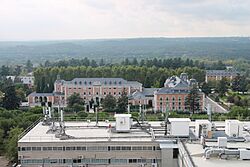
The Office of the Prime Minister (Spanish: Presidencia del Gobierno) is made up of government departments, services, and staff. They help the prime minister do their job. This office was created around 1834. Today, it works like a ministerial department, even though it's not officially one. About 2,000 people work there.
The main parts of the Prime Minister's Office include:
- The Ministry of the Presidency, Justice and Relations with the Cortes.
- The Cabinet Office, led by the Moncloa Chief of Staff.
- The Office for Economic Affairs and G20.
- The Secretariat of State for Press.
The Patrimonio Nacional, which manages royal properties, also works under this Office.
Security and Transport for the Prime Minister
The Cabinet Office handles security and protocol. Inside the Cabinet Office, there is a Department of Security of the Presidency of the Government (DSPG). This department works with the National Police and the Civil Guard. They protect the prime minister and their family. They also protect the buildings and staff at the Moncloa Government Complex.
The prime minister's vehicles come from the State Vehicle Fleet (PME). This agency provides vehicles and trained drivers to the government. The prime minister and other government officials travel by air using planes from the 45th Wing and helicopters from the 402nd Air Force Squadron.
When a Prime Minister Resigns or Parliament is Dissolved
The Parliament and the Government serve for a term of no more than four years. Before this time is up, the prime minister can resign. If the prime minister resigns and also advises the King or Queen to dissolve Parliament, then the King or Queen will call for a snap election. This new election cannot happen sooner than one year after the previous general election.
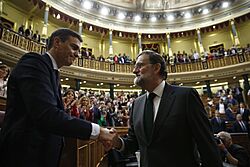
If a prime minister resigns without calling for new elections, dies, or becomes unable to do their job, the entire government resigns. Then, the process of royal nomination and appointment begins again. The deputy prime minister, or the next most senior minister, would temporarily take over daily operations. Also, if four years pass and the prime minister has not asked to dissolve Parliament, the King or Queen must dissolve it and call for a new general election.
The Parliament has two ways to force the prime minister to resign: by passing a motion of no confidence or by rejecting a motion of confidence. In the first case, a prime minister can only be removed if the motion of no confidence also names a new prime minister. If this motion passes, the new candidate automatically becomes prime minister. As of 2023, only Pedro Sánchez successfully removed a sitting prime minister with a vote of no confidence in 2018. In the second case, the prime minister can ask Congress for a vote of confidence in their government's policies. If Congress does not give confidence, the prime minister must resign. As of 2023, only prime ministers Adolfo Suárez in 1980 and Felipe González in 1990 proposed a vote of confidence, and both were successful.
Prime Minister's Importance and Privileges
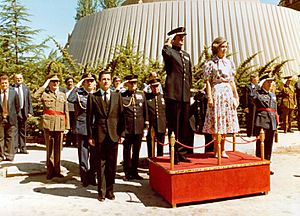
The Prime Minister is the second most important authority in Spain. They rank higher than all other state officials, except for members of the royal family.
In 2025, the Prime Minister's salary was €90,010. They also received an extra €13,892 as a member of parliament. The prime minister is not the highest-paid official in Spain. Other officials, like the King, the Queen, and the President of the Congress of Deputies, earn more.
The prime minister is protected from regular legal action. While they don't have full legal immunity like the King, the prime minister, along with royal family members, the government, and members of Parliament, can only be tried by the Criminal Chamber of the Supreme Court.
By custom, the prime minister is addressed as "The Most Excellent" (Spanish: Excelentísimo Señor or Spanish: Excelentísima Señora). This title is also given to government ministers. It is reinforced because the prime minister is a member of the Order of Charles III.
Deputy Prime Minister

The Spanish Constitution allows for the role of deputy prime minister. It also allows for more than one deputy prime minister. The position of deputy prime minister has existed on and off since 1840. The Constitution supports what was set in the Organic Act of the State in 1967. This law first allowed for more than one deputy. In 1974, Prime Minister Carlos Arias Navarro appointed three deputies. Since then, three other prime ministers have had more than one deputy. The second and third governments of Pedro Sánchez had the most, with four deputies.
Who Takes Over if the Prime Minister Dies?
According to Article 101 of the Spanish Constitution, the prime minister and their government leave office if the prime minister resigns, loses a vote of confidence, faces a successful motion of no confidence, or dies. In the first three cases, the prime minister stays on as a temporary leader until a new one is chosen by the Congress.
If the Prime Minister dies, the 1997 Government Act says that the Deputy Prime Minister takes over. If there is more than one, they take over in their order of seniority. If there is no deputy prime minister, the Act states that the ministers take over based on the order of their departments. This means the Minister of Foreign Affairs would be first, followed by the Minister of Justice, the Minister of Defense, and the Minister of Finance. These four ministries were the first major offices created in 1714.
The Order of Charles III
The Order of Charles III is Spain's highest civil honor. King Charles III created it in 1771. The current rules for the order, set in 2002, state that the prime minister is the Grand Chancellor of the Order. This means they are second only to the King or Queen, who is the Grand Master.
When a new prime minister takes office, they are given the rank of Knight or Dame Grand Cross of the Order. With this rank, they act as the Grand Chancellor. It is the Grand Chancellor's job to present royal decrees for the highest ranks of the Order to the Council of Ministers for approval. All titles for the different ranks of the Order must have the prime minister's signature and the monarch's.
The most recent people to join the order were Teresa Ribera and José Luis Escrivá. They both received the Grand Cross for their work as government ministers.
Retirement Honors and Privileges
When a prime minister retires, the King or Queen usually grants them an honor. This is often the Collar of the Order of Isabella the Catholic, which is the second highest civil honor. Ministers usually receive the Grand Cross of the Order of Charles III. This is because the prime minister already holds the Grand Cross of the Order of Charles III when they take office.
Besides these honors, the King or Queen might offer a former prime minister a noble title. These are the highest marks of distinction the King can give. When a title is created for a former prime minister, the new prime minister usually signs the royal order.
Many noble titles were given to prime ministers and ministers before the time of King Alfonso XIII. For example, the Dukedom of Prim was given to the daughter of Prime Minister Juan Prim. King Alfonso XIII made it a tradition to grant these honors. He gave 16 such honors to former prime ministers or their families. King Juan Carlos I wanted to bring back this tradition. He gave noble titles to Adolfo Suárez (who became Duke of Suárez in 1981) and Leopoldo Calvo-Sotelo (who became Marquess of the Ría de Ribadeo in 2002). The last prime minister to be offered a noble title was Felipe González, but he said no. Since then, neither King Juan Carlos I nor King Felipe VI have offered such honors to prime ministers.
Staff, Salary, and Office After Retirement
In 1983, the government of Felipe González created the "Statute of Former Prime Ministers." This law gave retired prime ministers the right to have an office with two civil servants for four years. They also received money for office expenses and an official car with a driver.
Nine years later, the law was updated. It removed the time limit for these privileges. Former prime ministers now receive diplomatic help abroad, security, a personal salary for two years after leaving office, and free public transport. They also get an amount of money for office expenses.
Since 2004, retired prime ministers can have a seat in the Council of State for life. As of 2025, only Jose María Aznar (2005–2006) and José Luis Rodríguez Zapatero (2011–2015) have used this privilege.
For the years 2023, 2024, and 2025, each living former prime minister receives €74,580 to help run their offices.
Recent Prime Ministers
Timeline of Prime Ministers Since 1975
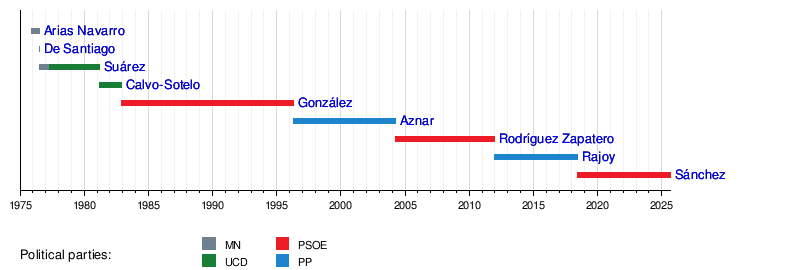
See also
 In Spanish: Presidente del Gobierno de España para niños
In Spanish: Presidente del Gobierno de España para niños
- Elections in Spain
- List of prime ministers of Spain
- Politics of Spain
- Cabinet Office (Spain)


